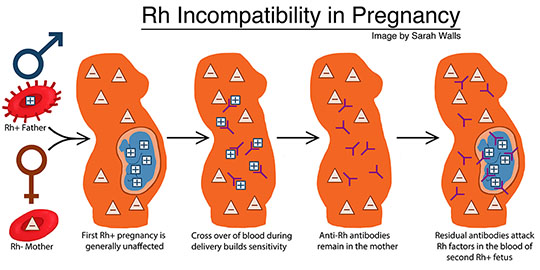
When Blood Types Shouldn’t Mix: Rh and Pregnancy
Illustrated by: Sabine Deviche
show/hide words to know
Juan and Lucy learned the hard way that some things should not mix. The two friends picked out chemicals their science teacher laid out to use in an experiment. They also thought it might be fun to grab some extra supplies from around the classroom, like water and sugar. Back at their station, they began mixing all sorts of cool chemicals, watching the liquid in their beaker change colors. It was fun until something bad happened.

Mixing chemicals in science class can be fun, but it can also be dangerous. Just like some chemicals shouldn't mix, neither should some blood types. Image by Lab-217074 via Picryl
They mixed a chemical called potassium chlorate with the sugar. Immediately a tall purple flame appeared with lots of smoke. The fire alarm went off, and they were in big trouble! They were only supposed to use what the teacher had set out and knew was safe.
Science class isn’t the only place where mixing different substances can cause bad reactions. It can also happen in pregnancy. One example is when a fetus and mother have different blood types.
You may have learned about blood types, based on the antigens of blood – type A or B (or both) or none (type O). But there’s another part of blood that makes someone Rh positive (Rh+) or Rh negative (Rh-). It’s called the rhesus factor. Sometimes the blood of an Rh positive (Rh+) fetus comes into contact with the blood of an Rh negative (Rh-) pregnant person. That can cause health problems for the fetus and the mother. We call that Rh (rhesus) incompatibility.
Passing Proteins
Have you ever heard of positive or negative blood types and wondered where the plus and minus signs come from? It comes from the absence or presence of the Rh factor.
The Rh factor is a protein often found on the surface of human red blood cells. Someone who has the Rh factor is Rh+ while someone without that specific protein on their red blood cells is Rh-. About 85% of people have the rhesus factor, which is why more people have A+ and B+ blood types than A- and B-.
We inherit the Rh factor from both parents. That means the pregnant person and fetus may have different Rh factors. In particular, big problems can happen when the fetus is Rh+ and the pregnant person is Rh-.
Attack of the Antibodies
Have you ever had a bad cold then felt better after a few days? That is because our bodies all have their own army of defense called an immune system that fights off foreign invaders. Normally, that keeps us healthy, but it can be a problem for Rh+ fetuses.
The pregnant person's blood travels to the fetus through the placenta to deliver nutrients. When an Rh- pregnant person's blood comes into contact with an Rh+ fetus’s blood, the pregnant person's cells see the Rh+ cells as invaders. Their body then begins making antibodies to attack the Rh+ invaders.
Our bodies store extra antibodies in our blood after fighting off an invader, in case it ever comes back. That way, if the invader does come back, the pre-made antibodies can get a head start on fighting it. This usually protects us from getting sick twice with the same illness.

The paler hand on the left belongs to someone with anemia. Anemia is when someone has a lower red blood cell count than they should have. It can be one of the consequences for a fetus born from Rh incompatibility. Image by James Heilman, MD via Wikimedia Commons.
The pregnant person's blood travels to the fetus, so the fetus also receives those antibodies. Normally, this helps the fetus build up its own strong immune system. But, it's dangerous when a fetus receives antibodies that want to destroy its Rh+ blood cells.
Danger in Numbers
It may surprise you that the first Rh+ fetus born to the Rh- pregnant person is usually fine. That is because the pregnant person's body does not make the antibodies against Rh+ blood cells until their blood has come into contact with the fetus’s. The first time the fetus' blood encounters the pregnant person’s blood is usually during childbirth.
If the pregnant person has a second fetus that is Rh+, things could get dangerous. By the time a person is pregnant again, their body has had time to build up antibodies against the Rh protein. That means the blood the pregnant person is passing to the second fetus already has the Rh+ antibodies. The antibodies pass through the placenta and attach to the red blood cells of the fetus.

Here, we can see an infant who appears yellow due to high bilirubin levels. Bilirubin is a product of the mother's antibodies breaking down the newborn's red blood cells. Image by rchristie via Flickr.
Hemolytic disease of the newborn, or HDN, is what we call it when those antibodies destroy the newborn’s red blood cells.
A fetus born with Rh incompatibility may also have yellow skin and eyes. Rh incompatibility can also cause heart failure and enlarged organs, or even death for the fetus or newborn.
Mystery Malady
One of the first cases of Rh incompatibility was reported in 1939. At the time, researchers had not yet discovered the Rh protein. Philip Levine, a researcher who worked with blood, and a physician named Rufus Stetson reported the case. They described a woman who came in at 33 weeks of pregnancy with complaints of pain and bleeding.
The woman gave birth the next day, and the newborn ended up dying. She continued having vaginal bleeding, so doctors took out her uterus. During her time in the hospital, she received over one hundred doses of other people's blood to replenish what she lost.

Rh stands for rhesus, the name of these monkeys. Landsteiner and Wiener studied rhesus monkeys to discover the role of the absence or presence of the protein. Because of that, they named the protein after the monkeys. Image by Timothy Gonsalves via Wikimedia Commons.
Tests showed that a lot of the plasma in her blood had agglutinated the blood from the donors. That means that the red blood cells stuck together and caused clumps. That can clog blood vessels in the body, which would prevent circulation and could cause death. Fortunately, Levine and Stetson did find some donors whose blood was compatible with the patient’s.
The physicians reported their data and findings, but they did not know what was causing her blood cells to stick together. Now we know that it was her immune system’s response to the Rh in some of the donor blood.
A year later in 1940, Karl Landsteiner and Alexander S. Wiener came up with the term “Rh factor” and found that it caused clumping after working with rhesus monkeys.
Preventing Pregnancy Problems
After years of research, doctors are able to help prevent Rh incompatibility from happening more often. RhoGAM is a type of medicine made from certain blood cells from Rh+ pregnant people who gave birth to Rh+ babies. Doctors give RhoGAM to Rh- pregnant people if there is a chance that they will have an Rh+ fetus.

A dose of RhoGAM is made up of a very small amount of Rh+ proteins. The medicine comes in a shot and stops a person's blood from making antibodies that attack Rh+ blood cells. Image by Sean Michael Ragan via Wikimedia Commons.
The pregnant person receives RhoGAM twice. The first time is around thirty weeks of pregnancy, and the second is soon after they deliver the fetus. RhoGAM reduces the risk of Rh incompatibility from ten to twenty percent to under one percent.
RhoGAM stops the pregnant person’s anti-Rh antibodies from attacking the fetus’s blood cells. For that reason, RhoGAM can also be used in the event of a miscarriage, another time the two blood types could meet.
As of 2023, we are still not sure of exactly what RhoGAM does in the body and only use it as prevention for Rh incompatibility. With more research, we hope to stop that condition from occurring at all.
Image of Sam the rhesus monkey by NASA via Picryl.
This Embryo Tale was edited by Cole Nichols and is based on the following Embryo Project articles:
Antonios, N. (2011, April 8). Rh Incompatibility in Pregnancy. Embryo Project Encyclopedia. ISSN: 1940-5030 http://embryo.asu.edu/handle/10776/2073.
O'Connor, K. (2011, May 11). Albert William Liley (1929–1983). Embryo Project Encyclopedia. ISSN: 1940-5030 http://embryo.asu.edu/handle/10776/2277.
External sources:
Freeborn, D., Trevino, H., and Burd, I. Rh Disease. University of Rochester Medical Center Health Encyclopedia. https://www.urmc.rochester.edu/encyclopedia/content.aspx?ContentTypeID=90&ContentID=P02498(link is external)
Mayo Clinic Staff. (2022, July 9). Rh Factor Blood Test. Mayo Clinic. https://www.mayoclinic.org/tests-procedures/rh-factor/(link is external)
View Citation

This is Sam the rhesus monkey, who went to space in 1959. Scientists have used rhesus monkeys to test all sorts of things, from space travel to medicine. The "Rh" in "Rh factor" stands for rhesus, because scientists used rhesus monkey blood to first find out about the protein.
Be Part of
Ask A Biologist
By volunteering, or simply sending us feedback on the site. Scientists, teachers, writers, illustrators, and translators are all important to the program. If you are interested in helping with the website we have a Volunteers page to get the process started.








